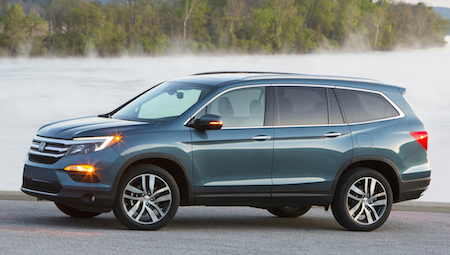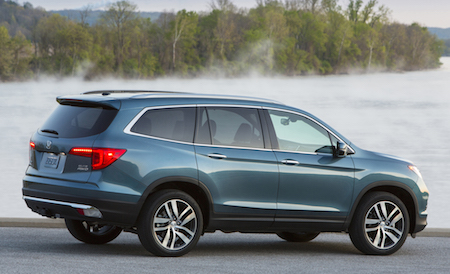2016 Honda Pilot – Finally Good Looking
- May 20, 2015
- Ford, Honda, New Model Introductions, On The Road: Driving Impressions
- Posted by George Peterson
- Comments Off on 2016 Honda Pilot – Finally Good Looking
The Honda Pilot, good as it might be, has been a blight on the road. Its eyeball searing gawky looks were only short of the not-lamented Pontiac Aztec. These are harsh comments, but a vehicle that makes you scream when you first see at an auto show is certainly a show stopper and not in a good way. Honda defends the previous Pilot as having traditional sport utility vehicle styling. That may be so, but it was very third world and inappropriate for the American market. Lasting for an extremely long cycle for Honda – seven years – the Pilot was a very good vehicle under the skin and its interior was commodious to say the least. But, now it’s thankfully dead and to be replaced by the third generation 2016 Honda Pilot on June 18, 2015.

New Pilot is a Good Looker The 2016 Honda Pilot is now well-styled with modern and contemporary lines. Gone is the BOX shape of the previous vehicle and curvaceous styling that is now more the norm has been adopted. Honda contends that Pilot moves from traditional and rugged (translated UGLY) to modern and refined. We agree. The 2016 Honda Pilot is a very good looker. The key, says Honda, is to keep Pilot’s capability and clothe it in a style that makes its buyer feel serene, athletic and smart.
All New Body and Chassis The 2016 Pilot is all new. New body and new chassis. Its 194.5 inch overall length is 3.5 inches longer than previously putting it in the league of the 2016 Ford Explorer (198.3 inches OAL). The passenger compartment has been lengthened by one inch. As before, Pilot has seven or eight passenger seating. Ingress to the third row seat has been improved by making the rear door opening 1.5 inches wider and 1.2 inches lower. Press a button and the second row seat flips forward out of the way – a child could do it.
Keeping up with the industry in the electronics department, Pilot has five fast-charging USB ports. Fully engaged in the battle for the center stack, Pilot adopts a Garmin navigation system with an 8-inch screen. The Android-based Display Audio System will seamlessly connect with an iPhone. The graphics are bright and intuitive. The optional rear seat entertainment system is Blu-ray capable and has an HDMI port, 115-volt power outlet, 2 headphone jacks and an auxiliary jack. Even the key fob gets into the action including: control settings, smart entry, push button start, remote engine start and remote-linked climate control.
Upgraded and More Efficient Pilot is almost 300 pounds lighter than its predecessor. It is standard with a 6-speed automatic transmission and the top of the line gets a ZF nine-speed automatic. The Earth Dreams 3.5L V6 puts out 280-horsepower and 262 lb ft of torque. Honda claims that the Pilot has best in class fuel economy and performance. The Pilot achieves 27mpg on the highway with its V6. With the 9-speed automatic, Pilot can hit 60mph in 7-seconds flat.
Honda has adopted a torque-vectoring all wheel drive system that achieves a weight reduction but improves performance. All wheel drive response time is 46% faster and torque capacity has improved by 20%. Torque vectoring senses what each wheel needs to do for optimum performance – front to rear and side to side. All wheel drive adds $1,800 to the price over a front wheel drive version of the Pilot.
Honda Sensing Brings Latest Nanny Features to Pilot Not a negative term, nanny features help keep you safe and secure. Honda engineers have optimized these features in its Honda Sensing Advanced Safety and Driver Assist Technology system. This system includes active cruise control, lane keeping assist, road departure mitigation, forward collision warning, lane departure warning. In the top of the line model, blind spot information and rear cross traffic monitoring is included.
New Elite Model Honda has recognized that it needs an even more luxurious model positioned above its Touring model. For the 2016 Honda Pilot an Elite model tops the range. The Elite includes a panoramic glass roof, LED headlights, blind spot monitoring system, front ventilated seats, rain sensing wipers and other convenience features. The MSRP for the Elite is $47,300 with AWD. This gives the 2016 Pilot a price spread (including destination) of $30,875 to $47,300 compared with $30,750 to $42,500 for the 2015 model.
Driving the Pilot The 2016 Honda Pilot is very quiet and comfortable. At the same time, it handles and maneuvers very well with no untoward ride motions. The engine is smooth and Pilot has one of the less intrusive stop-start systems in the industry. Honda has been able to tame the ZF 9-speed automatic better than most with shifts smooth and un-obtrusive. Interior ergonomics are outstanding. Visibility is top notch.
2016 Honda Pilot vs. 2016 Ford Explorer Honda’s very, very long embargo on impressions from the review of the Pilot let Ford slip in a brief review of the 2016 Ford Explorer. Since the Explorer review was in San Diego last week with no embargo it cries for a comparison with the new Pilot. Ford, like Honda, claims Best-In-Class for almost everything: NVH, performance, fuel economy, new range-topping model. Some of these are obvious. Ford is available with a 365-horsepower twin turbo EcoBoost 3.5L V6. Honda cannot match that, so the performance claim has to go to Ford. Fuel economy is a bit more of a problem. Honda’s 27mpg with its 3.5L V6 is 1mpg less than Explorer’s 2.3L EcoBoost 4-cylinder that has 280 horsepower and 310 lb of torque – better than Honda’s V6. But Ford’s base 3.5L V6 gets only 24mpg on the highway. Explorer’s new top-of-the-line Platinum Series throws all the options on the vehicle and is priced at around $53,000. So, Ford probably wins the battle of the bragging rights, but the Pilot seems quieter than Explorer and maybe a little more pleasant to drive.

